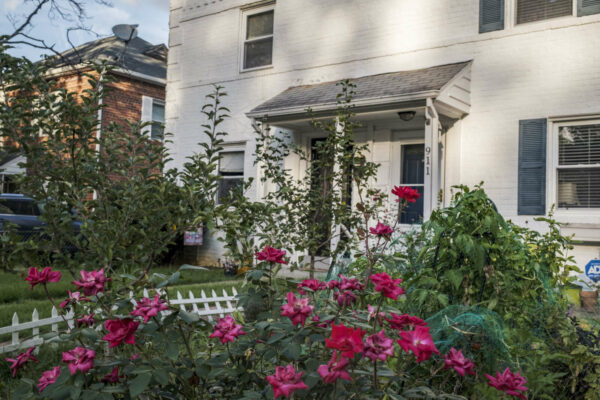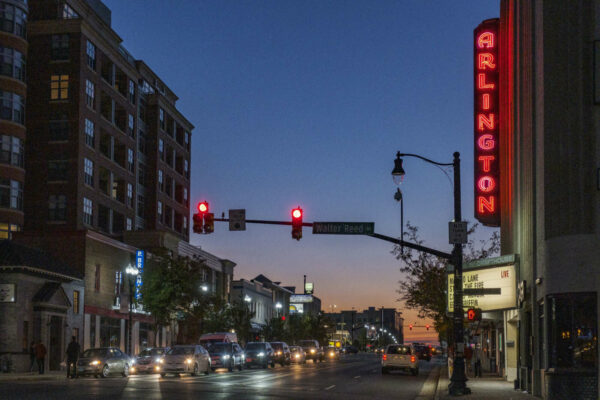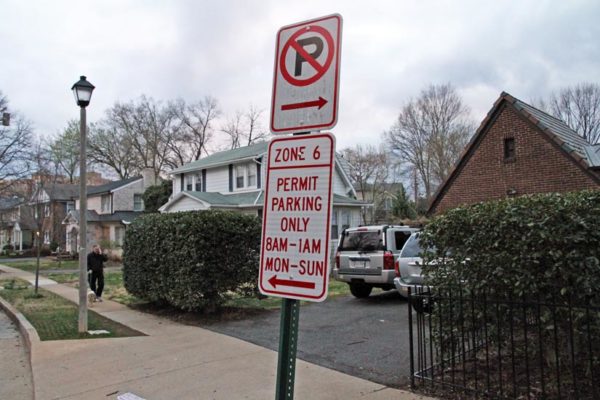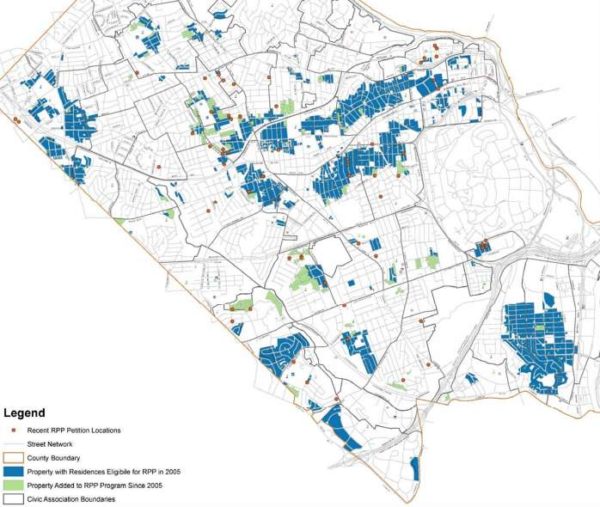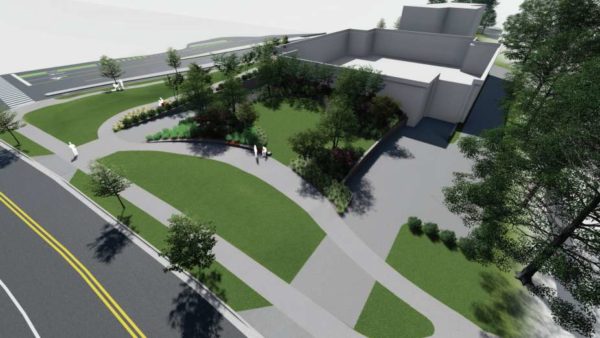Final approvals could be imminent for a high-rise apartment building proposed for the long-vacant Wendy’s lot.
Plans to redevelop 2025 Clarendon Blvd are set for Planning Commission and County Board votes next month, beginning with the Planning Commission on March 7. The County Board is expected to review the plans during its Saturday meeting on March 19.
Greystar Real Estate Partners is proposing to turn the 0.57-acre lot about a block from the Courthouse Metro station into a 16-story apartment building, with 231 residential units and 4,000 square feet of ground-floor retail. Residents will have 75 vehicle parking spaces and one bike parking spot for every unit.
As part of the project, Greystar is adding a public plaza at the tip of western edge of the site — where N. Courthouse Road and Wilson and Clarendon Blvd intersect — and an alley along the eastern edge.
The site languished for years after the Wendy’s and a bank were torn down to make room for a 12-story office building proposed by Carr Properties — which was never built because Carr couldn’t secure a tenant.
The lot has been used as a staging area for 2000 Clarendon, a condo project across the street, as the site changed hands and Greystar drafted new plans for apartments.
Last fall, most residents who participated in a public engagement process seemed to welcome the switch from office to residential use, although they were divided on the low parking ratio and the height, given the one-story retail and low-rise brick apartment buildings nearby.
The proposal is much taller than the recommended maximum of 10 stories in the Rosslyn to Courthouse Urban Design Study.
But Greystar was able to nearly double the number of units it could pack onto the site and increase the building height by six stories through a 104,789 square foot transfer of development rights from Wakefield Manor, a small garden-apartment complex deemed to be historic, located less than a half-mile from the proposed development.
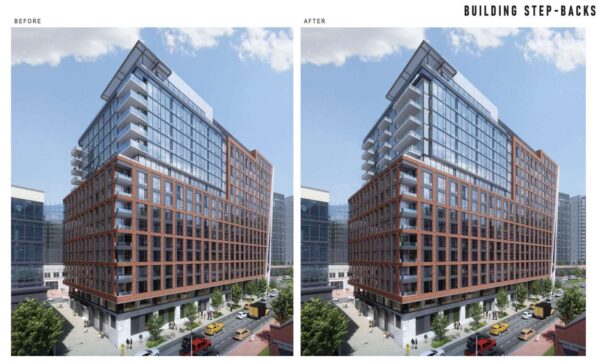
Greystar did adjust the project a bit in response to community and staff feedback.
To make the building feel less bulky, it removed columns running along the ground of the public plaza as well as some patios on the upper stories, Walsh Colucci land use attorney Nick Cummings said during a November presentation.
During the same meeting, county planner Adam Watson said Arlington continues to work with Greystar to make the plaza more vibrant than a concrete slab, with more plantings, movable seating and diverse building materials.
“There’s a number of things we’re working on to get there,” he said.

Greystar, meanwhile, is currently building new apartments a stone’s throw away in Courthouse on the “Landmark Block” (2050 Wilson Blvd). This project is poised to realize a significant portion of a 2015 vision to transform the neighborhood.
A few more county projects and private developments have to get underway, however, for the vision to be fully realized.
Arlington’s planning division is looking to change the definition of a “family” in the county’s zoning code.
Housing planners say this would stop potentially exclusionary housing practices that discriminate against larger groups of unrelated residents who live together in order to afford staying in Arlington, where home prices and property taxes are rising and there’s a shortage of affordable housing options.
Currently, Arlington’s Zoning Ordinance says up to four unrelated people living together — including “servants,” in a peculiar anachronism — can constitute a “family.” The Department of Community Planning, Housing and Development staff intend to review and possibly write an alternative definition that eliminates the four-person cap.
The code also defines “family” as: a single person living in a household; two or more people living together who are related by blood, marriage, adoption or foster care; or up to eight people who are elderly, sick or disabled living with staff or counselors in a state-licensed facility.
Planning Commission Chair David Weir says he welcomes CPHD’s intentions to do away with the “exclusionary, inaccurate terminology of ‘single-family’ and ‘multifamily’ homes.”
“It’s tempting, I think, to see this change as minimal or immaterial but it’s neither of those things,” he said during a joint CPHD-County Board work session last week. “The difference between zoning for families and zoning for households is as fundamental a matter as the right to choose the people with whom we share our lives, and zoning ordinances are lagging behind other fields of law — like, for example, family law — in recognizing this.”
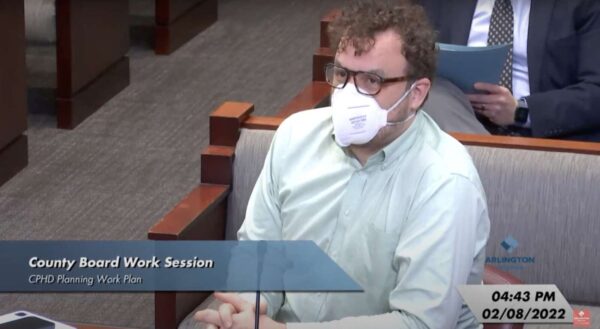
Weir recalled when the late County Board member Erik Gutshall realized in a zoning meeting that his family of four probably lived in violation of county ordinances when they took in a foreign exchange student.
“A group of people who choose to share their lives in ways that don’t meet the Mayberry formalities must not for that reason alone be unwelcome in the definitions of the laws that shape how their homes are built,” he said.
County planners have recommended this change for a few years now, saying that people are choosing to live together to afford Arlington prices and access its schools and job opportunities.
“There’s been a rise in the number of non-traditional households living together for socio-economic reasons, such as pooling resources to find affordable housing near good schools or job centers,” county housing planner Joel Franklin said at a 2020 Tenant-Landlord Commission meeting. “For that reason, it was recommended to amend the zoning ordinance to be more inclusive of non-traditional families.”
That recommendation was in the 2019 draft Analysis of Impediments to Fair Housing, according to CPHD spokeswoman Erika Moore. The analysis concludes that the cap disadvantages residents who have been priced out of single-family homes.
“As the norms of the American family are shifting, it is apparent that single-family housing is less viable, increasingly unaffordable, and not achieving fairness and inclusion,” it says. “Placing restrictions on the number of unrelated persons living together but who function as a single housekeeping unit restricts housing choice for households comprised of persons living together for economic or other reasons.”
Changing or eliminating the four-person cap dates back at least to 2015, when the County Board adopted the Affordable Housing Master Plan, Moore said. The plan says a more flexible definition is one way the county can try to meet its affordable housing needs through 2040.
While making the change is on the agenda for CPHD, a new definition won’t come overnight.
The planning division identified revising the definition as a second-tier priority for 2022, falling behind more pressing zoning study areas — such as allowing permanent outdoor dining options, permitting micro-fulfillment centers to operate in vacant office buildings and adding elder care housing options in the code.
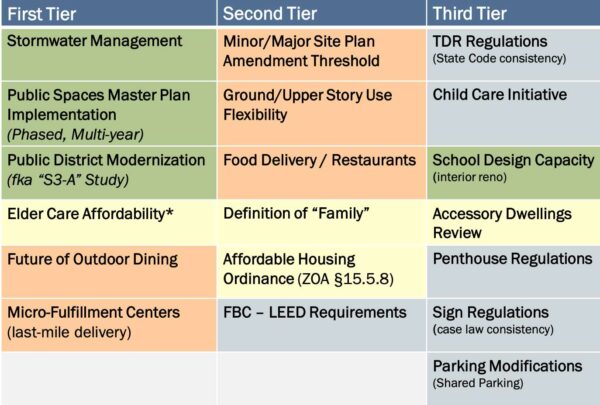
Updating the definition would require the county to start a zoning study to examine alternative definitions and develop amendments to the Zoning Ordinance, Moore said.
The Arlington Planning Commission gave a proposed Columbia Pike residential redevelopment the thumbs-up.
Now, plans to replace an aging, one-story retail strip in the 2600 block of Columbia Pike will head to the County Board for approval during its recessed meeting on Tuesday, Feb. 17.
Arlington-based Insight Property Group proposes to tear down the Fillmore Gardens Shopping Center at the corner of Columbia Pike and S. Walter Reed Drive and build a multifamily building with ground floor retail. The six-story building, dubbed “The Elliott,” will situate 247 market-rate apartments above a grocery store (rumored to be an Amazon Fresh), a renovated CVS pharmacy and three levels of below-grade parking.
“This project has been a work in progress for several years now,” said Tad Lunger, the land use attorney representing the project. “As you know, it is a very prominent site in a town center on Columbia Pike, which was envisioned to accomplish a number of planning and community goals. The culmination of these goals has informed every aspect of this proposal.”
The developer will contribute land on the eastern edge of the site to the second phase of Penrose Square Park. This will nearly double the park’s size, and allow the two sculptures that comprise the public art installation “Echo” to be farther apart, as originally envisioned by its artist.
It will also build a new S. Cleveland Street, which separates the park and the site, a pedestrian passageway along the western edge of the site and an alley to the north.
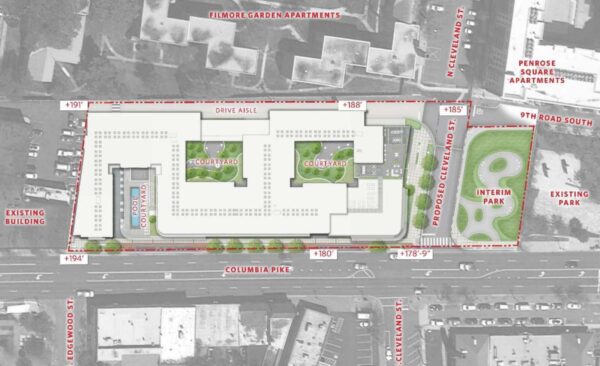
Residents will have access to four amenity spaces: two internal courtyards, a pool courtyard overlooking the pedestrian passageway and a rooftop space. Insight Property Group is aiming for LEED Silver certification of the building.
Once engineering, building and landscape plans are finalized, demolition could begin in early fall, Erika Moore, a spokeswoman with the Department of Community, Planning, Housing and Development, previously told ARLnow. If that starts on time, construction would likely conclude by early 2025.
Members of the Planning Commission praised the project and had few questions.
“I’m excited by the presentation, and I’m excited to see this move forward,” said Daniel Weir, speaking not as the Planning Commission Chair but as a member. “I’m very happy as well with what we’ve been presented with.”
That there were no public speakers and few questions demonstrates how the Columbia Pike Form Based Code — which guides development on the Pike and favors mid-rise apartments with ground-floor retail — helped realize an “amazing building,” Commissioner Stephen Hughes said.
“Our long list of public speakers and fellow commissioners who have poignant things to add is a big old goose egg,” he said. “We stand on the shoulders of giants who helped build the original plan and worked to ensure the balancing act of many different areas were heard, communicated and then held to.”
The alley prompted one question from Commissioner Tenley Peterson, who referenced two car accidents involving alleys in November — one involving a toddler in Westover and the other an adult on a motorcycle who died of his injuries — that prompted a county task force to study alley safety.
In a bid to bring more businesses to Columbia Pike, Arlington County staff are seeking to ease zoning regulations for the area.
The Pike could see a variety of light industry businesses, from animal boarding to breweries to indoor urban farms, if the County Board approves the changes, which are slated for a vote next Saturday, Nov. 13.
Development along Columbia Pike is governed by the Columbia Pike Form Based Code, which favors mid-rise mixed-use buildings with housing and ground-floor retail. The kinds of commercial operations the code currently allows by-right or with a use permit, however, are limited.
Permitted uses on the Pike were last revised in 2015 and, according to the county, “the nature of retail has since shifted,” warranting another update. After studying market conditions on the Pike in 2019, staff decided updating the code was the best way to encourage commercial activity.
“Increasing use flexibility through zoning and land use recommendation was identified as most efficient and impactful step to move work forward and permit wider range of uses,” county planner Ebony Dumas told the Planning Commission last night (Monday) during a meeting.
She noted business and community leaders have also advocated for greater retail flexibility to tackle the high vacancy and turnover rates for ground-floor retail and to eliminate use permits, which can be a substantial hurdle for new entrepreneurs.
“There’s a lot of support to update and consider new uses,” Dumas said, recapping the last year’s worth of community engagement on the proposal. “Most agree the existing use table over-utilizes use permits, and more uses should be by-right.”
Commissioner Stephen Hughes credited the last night’s proposal to community advocacy.
“Neighbors, business leaders and business owners all along the Pike have pretty much from day one said, ‘What we want is business, what we want are people, what we want is livelihoods,’ and with that, they want the maximum flexibility possible,” he said.
Arlington County staff propose allowing by-right more variety in office uses, such as recording studios, as well as museums, art galleries and studios. The proposal would allow uses typically seen in industrial districts but currently prohibited under the Pike code, including animal boarding, breweries, distilleries and cideries, artisan workshops, shared commercial kitchens and urban agriculture.
Of the new uses, staff proposed allowing shared kitchens and urban agriculture by-right, meaning business owners would not need a use permit, which makes them subject to certain conditions. Last night, the Planning Commission unanimously voted in favor of allowing beverage facilities and other artisan workshops by-right, too.
“We’re trying to encourage smaller businesses,” Commission Chair Jim Lantelme said. “From simply an economic development point of view, and trying to encourage small businesses, which do contribute to vitality of neighborhood, if wherever we can do it by-right, that’s the best way to go.”
The cement spheres of “Dark Star Park” in Rosslyn, the electric blue ribbon of “Dressed Up and Pinned” in Courthouse and the twin striped monoliths of “Echo” in the park at Penrose Square.
These are some of the roughly 70 permanent public art projects in Arlington, commissioned for county capital improvement projects, sponsored by developers or initiated by communities.
Made with cement, steel and stone, these permanent projects are built to last, such as “Dark Star Park,” installed in 1984. The focus on permanent art installations — in particular those integrated into large capital projects — is intentional, according to Arlington’s Public Art program, a subdivision of Arlington Economic Development’s Cultural Affairs division.
“For as long as you have me leading the program for Arlington County, you’re going to have someone fighting for the very difficult work of integrating public art into larger county capital projects,” Public Art Administrator Angela Adams said in a recent Planning Commission meeting. “It’s not the easy thing to do. Temporary public art is the easy thing to do. Murals are the easy thing to do. We don’t do murals: we assist the community to do their own murals.”
The county considers murals, which can last a few decades if maintained well, temporary public art. Most recently, the program provided assistance for the creation of the John M. Langston mural at Sport Fair by KaliQ Crosby.
The county’s emphasis on sculptures over murals and other temporary works received some pushback from Planning Commission members during a discussion about the county’s Public Art Master Plan, which is being updated to reflect modern times.
After multiple years of community engagement and study, arts staff drafted an update to the plan — first adopted in 2004 — that reached the County Board last Saturday. Members approved a request to advertise a public hearing on the updated document next month, ahead of a vote on whether to adopt it.
“It’s a strategy for how public art will improve the quality of our public spaces,” Board Chair Matt de Ferranti said during the meeting. “We each got briefed on this. I think it’s important.”
The Public Art program’s current emphasis on sculptures and other installations, like the lighted bridge over Route 50 near Courthouse and Corridor of Light in Rosslyn, prioritizes the permanent over the ephemeral, quality over quantity. But it also comes at a cost, often requiring significant funding and years of planning. Plus the artists with the reputation and know-how to create such art in many cases come from out of town.
By contrast, the public art one more commonly sees posted on social media these days are of the more temporary variety: Instagrammable murals and community-created installations. Cheaper and impermanent, such art has the possibility of being more ubiquitous around town and more reflective of the current moment and the local flavor. Such is the case with a mural unveiled over the summer in the Town of Vienna, a set of painted, social-media-ready butterfly wings designed by a graduate of a local high school.

Public art by the numbers
Since the 1970s, Arlington County and private developers have completed more than 100 permanent and temporary works of public art. But it wasn’t until 2004 that a systematic approach, called the Public Art Master Plan (PAMP), was codified.
More than 25 permanent projects have been completed or are in progress, while more than 30 temporary works have been commissioned or supported since the PAMP was adopted, the updated plan says. These are funded by county capital improvement funds and developer contributions to the Public Art Fund.
Developers have completed and commissioned more than 25 works to adorn their sites, Public Art program spokesman Jim Byers, Jr. said. Most developers (65%) contribute to the Public Art Fund, which has received 59 contributions since 2004 and today maintains a balance of $3 million, he said.
Their coffers go a long way, Byers said, as “developer and partner funding leverages the county Public Art funding by nearly 25:1.”
Out with the old, in with the new
Despite its successes, the PAMP update says the county’s public art approach needed a fresh coat of paint “to support the County’s civic engagement, planning, economic development and placemaking.”
Among other new priorities, the new plan emphasizes audience development and engagement and equity, and identifies two new priority corridors: Langston Blvd and the Potomac Riverfront. The existing priority corridors are Rosslyn-Ballston, Richmond Highway, Columbia Pike and Four Mile Run.
Audience engagement is a priority because residents seem to know little about the program, the plan admits. It calls for more programming to engage folks and more accessible information about projects.
“One of the things the research showed is that the Arlington community is not fully aware of the breadth of the County’s public art resources,” the PAMP continues. “It is important not only to commission new works, but also to find ways to keep existing artworks fresh in people’s minds.”
Since 1980, Glebe Road has been considered the border between central and west Ballston.
But in recent years, the dividing lines drawn in Ballston’s 40-year-old sector plan have become more stark, with businesses thriving in one area and struggling in another.
Today, Ballston contains the densest census tract in the D.C. area. As more apartments and retail are proposed and built, however, some argue that the county needs to address the impact of uneven development on either side of Glebe.
Many of the new business openings orbit the Ballston Quarter mall and the ground floor of Ballston Exchange, both in the central part of the neighborhood. But west of Glebe Road and north of Carlin Springs Road — which is technically part of the Bluemont Civic Association — there have been numerous high-profile closures.
Leaders in planning and business development have different ideas for improving west Ballston, but they do share an interest in making it welcoming, walkable and sustainable without getting into the weeds of a sector plan update. During a joint County Board and Planning Commission meeting this month, Planning Commission Vice-Chair Daniel Weir stressed the importance of re-examining Ballston in the near future.
“Glebe Road continues to become a wall that separates east and west Ballston, which are separate communities,” Weir said. “Pedestrians and people not in cars are unwilling to cross five to seven lanes of traffic to get a very excellent donut or to go to one of the many restaurants that have been circulating through some of the bays there.”
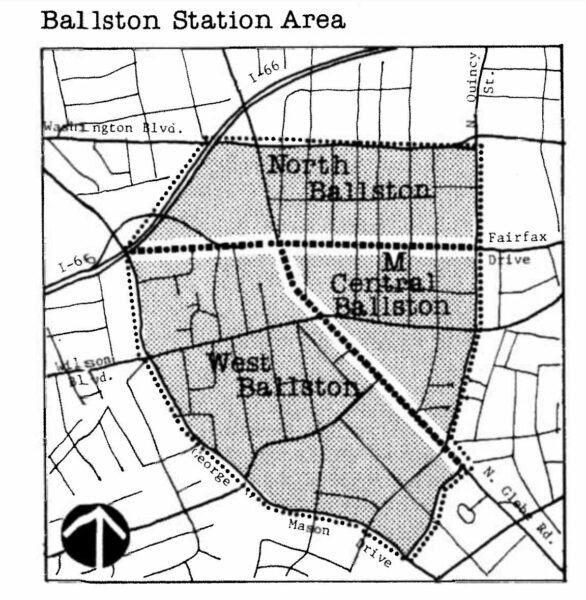
Rather than rewrite the admittedly old sector plan, which county staff don’t have the capacity for, he said they ought to take “a more agile, nimble approach.”
“It doesn’t need to be completed in 2022, but it’s an opportunity we can and should think about, especially since, if done right, it could be a model for more agile sector planning going forward,” he said.
Ballston BID CEO Tina Leone agrees that Glebe Road is a problem. She says no other road elicits the same number of complaints, ranging from excessive vehicle speed to unnerving pedestrian crossings. She suggested extending the sidewalks, turning some parking spaces into parklets and widening the medians.
“We need to come together as a neighborhood and work with county to solve the problem,” Leone tells ARLnow. “There hasn’t been a plan — everyone does their own thing and no one is looking at Glebe Road as an entity.”
In response, Arlington County’s Department of Community, Planning, Housing and Development said it is using and will continue to use opportunities during development, capital improvements and county programs such as Vision Zero to improve Ballston’s walkability.
“Over the past two decades, we’ve worked with partners to make N. Glebe Road in Ballston safer and more attractive for all users and have better integrated the street within Ballston’s overall urban fabric,” CPHD Director Anthony Fusarelli, Jr. said. “The County will continue to make the most of similar opportunities in the future.”
“Enhancements have occurred thanks to the combination of infill development, streetscape improvements, signalized pedestrian crossings, intersection improvements, and curb space management techniques, all of which have collectively and significantly improved the experience of traveling along and across N. Glebe Road in this area,” Fusarelli added.
Arlington’s planning department is stretched too thin and cannot take on a bigger workload, its director told the County Board this week.
At full strength, the 30-person staff of the Department of Community, Planning and Housing Development shepherds a myriad development projects and permit applications through county processes, from cafés seeking to renew their outdoor dining permits to developers planning large-scale projects. It also helps to produce the lengthy planning documents that guide the future development of neighborhoods.
Right now, with a flurry of activity underway in the wake of the arrival of Amazon’s HQ2, seven major long-range planning studies are in process. The department anticipates overseeing 10 major development applications while working through more than 400 minor development and administrative approvals, CPHD Director Anthony Fusarelli, Jr. told the Planning Commission and the County Board during a joint meeting.
“To have this number of ongoing planning efforts and engagements at one time… truly represents a substantial volume of ongoing work being managed by the division, also requiring time energy and resources by other county staff and the community,” Fusarelli said during his presentation. “Collectively, these ongoing efforts command a significant amount of staff resources, leaving little if any capacity to add new work and initiate additional projects at this time.”
Once major projects are done or big milestones reached, he said staff will be freed up to start new initiatives or address new county priorities.
While deferential to the hard work of CPHD, Planning Commission and County Board members had a few ideas for work CPHD should undertake in the near future, from changing how the county evaluates the environmental impact of developments to not losing sight of deferred projects such as implementing the plan to enliven Four Mile Run Valley.
One potential change could save CPHD time and resources, argued Planning Commission Chair James Lantelme. Currently, renovations to “non-conforming” duplexes, townhouses and low-rise multifamily buildings go through the same lengthy approval process used for major developments, known as Site Plan Review. He suggested instead that these folks, who want relief from zoning regulations, go through the Board of Zoning Appeals, which hears similar requests from those on single-family residential lots.
“I’m assuming we’re going to be seeing more of these small things coming before us, and we think we really need to deal with this,” Lantelme said. “It’s a waste of the Planning Commission’s time, it’s a waste of staff time. We have a huge amount of consequential work, and to have a Site Plan for one duplex… there’s no value added by doing that. It’s not appropriate, and in fact, it’s contrary to what our comprehensive plan is advocating for, for affordable housing — for housing period — and for equity.”
It’s likely on his mind because the commission oversaw one such project, a request to build out the deck of a townhouse, which recently received County Board approval, and members are now reviewing another, a duplex renovation proposed by the owner. The approvals feature televised, public meetings and detailed presentations created by planning staffers.
You're forgiven if, looking at this discussion list, you thought this was a 100-unit brand new residential building.
NOPE.
Duplex. pic.twitter.com/dFRJ1mAAgT
— Stephen Repetski (@srepetsk) September 17, 2021
The townhome was in a “legacy district” used for a few developments in the 1970s, while duplex sits on a smaller-than-standard lot that had been grandfathered into a zoning district. Both owners proposed increasing the footprint of their home, tipping them into the Site Plan Review path, which requires lawyers, experts, and Planning Commission and County Board approvals.
“If it was a McMansion, it would go through BZA,” Lantelme said. “You have to go through more time, expense and uncertainty in order to have a duplex, which is what we want in these areas… It would really save us time money and staff resources if we could get this addressed.”
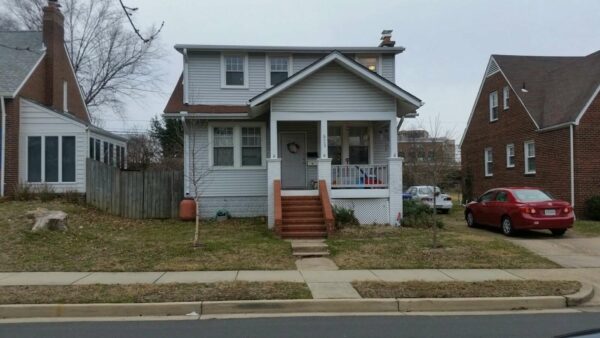
(Updated at 6:15 p.m.) Seven years ago, Les Garrison bought a two-family home in the Aurora Highlands neighborhood so that his son’s family could live in one half and the other could be rented out.
He had always intended to renovate the home near Crystal City, which consists of two apartments, each with two bedrooms and one bathroom. He also wants to modernize it, making it accessible to people with disabilities and adding solar panels.
Garrison tells ARLnow he wants to provide an affordable housing option to his son, a county employee, and people like his other tenants — two women over 60, a barista and a graduate student.
“My son… he can’t afford to live in this neighborhood, unless we have revenue coming in from the house,” Garrison said. “That’s what this is about: allowing him to stay in Arlington.”
He expected to get approvals in 2017 and start construction in 2018. Instead, his plan to enlarge and modernize the house will require approvals from the Planning Commission and the County Board as part of a more complex county permitting track that even features a county webpage devoted to the project.
The Garrison’s Site Plan Review process, which involves more scrutiny and more revisions to attain the green light to start construction than an administrative approval typical for single-family homes in Arlington, has also put him out nearly $100,000 in permitting fees, and payments to lawyers, architects and arborists.
Although dates have not yet been set for County Board approval, the Garrison residence would be the second duplex project to go before the board this year. Members approved construction at a Ballston duplex at 1201 N. Vernon Street in May. Meanwhile, from January through June, the county has administratively approved construction of 66 single-family detached homes and construction started on 27 similarly-approved townhouses.
This disparity has drawn criticism from some members of the Planning Commission, who are the last to provide input before sending a project to the County Board for a virtual rubber stamp, as well as housing advocates, who say this reflects a “broken” zoning code.
County staff, meanwhile, say that changes Garrison is proposing require community input. But, they said relief for duplex homeowners in similar situations could come in the future, if zoning standards are changed for lower-density multifamily housing types as part of the in-progress Missing Middle Housing Study.
That might put homeowner renovations of duplexes that don’t confirm to current zoning on the same regulatory playing field as the tear-downs that have become commonplace across the county.
“Right now, a builder can put up a 3,000 square foot house and sell it. It’s pretty much that simple — no public meetings, no expensive lawyers, no neighborhoods weighing in on, I don’t know, whether your driveway pavers should be beige or gray,” said Daniel Weir, who is the vice-chair of the Planning Commission. “Split that exact same building in half — same amount of driveway, same amount of parking, same lot lines — try and build literally almost the exact same building, and all of a sudden everyone in the county gets to have a say.”
Amazon is in the process of hiring for nearly 2,000 open positions in Arlington, while it also reveals new renderings of the planned second phase of its HQ2 in Pentagon City.
Additional renderings of HQ2 Phase 2 were released by the company this morning, showing a conceptual view of “The Forest” plaza from S. Elm Street — including the base of the lush, futuristic “Helix” tower — as well as a view of the S. Fern Street Plaza that will host community events and a number of retail businesses.
The renderings “illustrate a nature-filled, pedestrian-friendly environment for all to enjoy and highlight Amazon’s continued commitment to building a neighborhood rather than a closed-off campus,” a PR rep for the company said. In addition to areas for events, Phase 2 will feature 115,000 square feet of retail and retail equivalent space across its four buildings.
The new views come as Amazon and its architecture firm prepare to present its HQ2 Phase 2 plans before Arlington’s Long Range Planning Committee tonight.
The second phase of the project will be built on the mostly vacant PenPlace site across from its Phase 1 construction site, a block from the Pentagon reservation and the Pentagon City Metro station. The company is still in the process of tearing down the former Residence Inn hotel on the site, which was once considered as a possible location for the Washington Nationals stadium.
As Amazon continues to build, it is also continuing to hire.
“Hiring across Amazon’s Arlington Headquarters is ramping up,” the tech giant said on its blog today. “Amazon is seeking 1,900 new employees for a variety of technical and non-tech jobs — this is the highest number of open positions at HQ2 since the company announced its selection of Arlington, Virginia as its second U.S. headquarters.”
“Currently more than 1,600 corporate Amazon employees call Arlington home,” the blog post adds. “Amazon’s more than $2.5-billion investment in HQ2 and the surrounding area will result in 25,000 Amazon jobs over the next decade, and thousands of indirect jobs across the entire region.”
Open positions in Arlington on Amazon’s jobs website include Alexa SmartHome software developer, Amazon Fresh Store designer, and Amazon Web Services Systems Engineer.
Last month an Amazon official said the company expects that most employees will return to offices after the pandemic, with some flexibility for remote work.
“But there is no substitute for Amazonians being together,” said the official, as quoted by the Washington Business Journal.
Proposed changes to Arlington’s Residential Permit Parking program, including a pay-to-park option for short-term visitors, will go before the County Board next week — with a caveat.
On Monday members of the Planning Commission hammered out the kinds of changes to the program that they want the County Board to consider. The matter is set to be taken up during the Board’s meeting on Saturday, Feb. 20.
The commission recommended a case-by-case approach to paid, short-term parking in neighborhoods — currently not an option in places where parking is restricted to residents and their guests only during certain hours — as members were divided on whether to include it at all. Some support it across all neighborhoods with RPP programs and others support the possibility of neighborhoods requesting it. A few oppose it full-stop.
“I can’t do this to my neighbors,” said Commissioner Denyse “Nia” Bagley, who opposes pay-to-park entirely.
Vice-Chair Daniel Weir said the two-hour parking meets “a whole host of needs” and unanticipated circumstances that “all fall under managing parking,” from when people go to nearby restaurants or visit friends. Short-term visitors would be able to legally park without a pass or permit and payments would be processed through the ParkMobile app or through the EasyPark device.
The RPP program was originally created as a response to commuters parking in residential neighborhoods near Arlington’s Metro stations and commercial centers. It survived a legal challenge that reached the U.S. Supreme Court in 1977, and later expanded to numerous neighborhoods around the county. Neighborhoods must petition for RPP zones, but in many cases those who live in apartments and condos are excluded from receiving permits, raising equity concerns.
The commission also recommended allotting on-street parking permits to household units based on whether they have off-street parking, such as driveways or garages. Households with off-street options can get up to two permits, one of which could be swapped for a FlexPass, a dashboard placard that can be used by residents or their visitors.
Residents without off-street parking are eligible for up to four on-street permits, one of which could be swapped for a FlexPass.
According to a county staff report presented to the commission, the cap is higher than what was previously proposed, “in response to concerns that unrelated adults (who may have more vehicles than a family household) sharing a home without off-street parking in an RPP zone could face an unnecessary hardship.” Still, it’s lower for those with off-street parking than the current program.
“The current program allows for up to four (4) permits, one (1) FlexPass and three (3) vehicle specific permit decals,” a previous staff report said. “Many households already in the RPP program would not be able to obtain as many permits as they do today Lowering the cap encourages households with multiple vehicles to use their off-street parking, leaving space on the street for others.”
The commission did not tweak the expansion of parking options and permits to employees of K-12 schools and group homes. In response to concerns about enforcing paid parking, commissioners unanimously voted to include language stipulating that parking enforcement should be on par with metered parking elsewhere in the county.
These potential changes come three years after a moratorium was placed on new parking restrictions so a review of the program could be conducted. The review concluded last fall, kicking off a new period of public engagement as the changes wound through county processes.
The changes went before the County Board for the first time in December, when Board members decided to delay a public hearing to give the community more time to digest the changes.
At the time, the County Board approved an amendment allowing residents to buy a third or fourth parking pass at a higher cost, after hearing from families who suddenly had adult children come home due to the pandemic, in addition to homeowners who said the program would force them to widen their driveways.
(Updated at 5 p.m. on 11/10/20) Dominion Energy and Arlington County are looking to swap two pieces of land near Crystal City.
On Saturday, the County Board is slated to consider a series of real estate and land use actions, including a land exchange agreement between Dominion and the county. Dominion offered to give the county a piece of property at the corner of 18th Street and S. Ives Street in exchange for a piece of county-owned land on the corner of S. Fern and S. Hayes streets.
The swap would allow Dominion to expand its substation — located roughly two blocks from Amazon’s under-construction HQ2 — to accommodate larger, newer equipment. Construction on the expansion is anticipated to start late in the first quarter of 2021.
The County is considering turning the Dominion property, the site of a previous substation, into a park.
In addition to updating the substation, Dominion is also trying to meet increasing demand for energy as the Pentagon City and Crystal City areas develop, said Michael Halewski, a real estate specialist from the Department of Environmental Services, during a meeting on Wednesday with Arlington’s Planning Commission.
“Dominion is on a tight time frame for the delivery of the increased electrical capacity to the community,” Halewski said.
The area needs more “redundancy and reliability” in the electrical services it provides, said Dominion spokesperson Peggy Fox in an email on Tuesday.
To get the extra physical space needed for the new equipment, Dominion looked to neighboring land. The county-owned property — an unused, grass-covered sliver along S. Hayes Street — did not have as many constraints, including underground public utilities, as other plots.
The original discussion about this exchange occurred in the summer of 2019, and in July 2020, Dominion submitted a rezoning application to the County Board.
In August, Dominion notified the neighboring civic associations of its plans, and invited feedback through a survey. It also purchased social media ads and held two virtual meetings.
“It was one of the more successful community engagements Dominion has had in response to one of its projects,” said Matthew Weinstein, counsel to Dominion Energy, during the Planning Commission meeting.
In response to feedback on the aesthetics of the substation, Dominion updated its permit to include a commitment to installing public art on-site, redesigning the plaza to improve the pedestrian and leisure experience and widening the sidewalk from four feet to six feet, said Dominion spokesperson Ann Gordon Mickel in a project update on Oct. 28.
Neighboring civic associations told county staff they had no issues with the substation rezoning proposals, but the Aurora Highlands Civic Association did express hesitancy with the exchange agreement.
“We’ve heard some concerns from the community about the environmental condition of the land,” said Halewski, the county staffer.
Environmental reports indicate that some areas of the old sub-station property would need to be remediated if dirt was disturbed and excavated. The soil could be used on-site or disposed of in a regulated landfill, he said.
“The cost of those different scenarios range from $0 if it’s a passive open space to approximately $55,000,” Halewski said. “This would be a county cost.”
Photos above (1-2) via Google Maps, (3-4) via Arlington County


